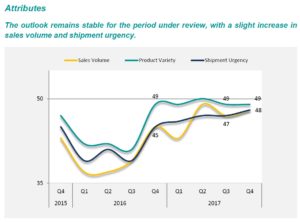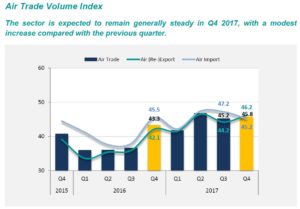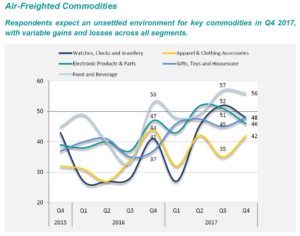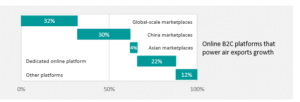Background
Hong Kong is one of the major regional and aviation hubs in Asia Pacific, and Hong Kong International Airport is globally recognized as one of the busiest airports in terms of international cargo throughput. The city’s dynamic air trade industry generates income of over HK$120bn annually and employs nearly 25,000 people (1, 2, 3) in the territory.
In the absence of a leading performance indicator for the industry, DHL Express (Hong Kong) Limited (DHL) has commissioned Hong Kong Productivity Council (HKPC) to conduct independent air trade research – the result of which is the DHL Hong Kong Air Trade Leading Index (DTI).
DTI, compiled after months of preparation and pilot studies, contains quarterly findings on air trade and its related attributes, market sentiment and key types of commodities.
DTI is the first of its kind in Hong Kong, offering publicly available market intelligence for local enterprises, especially SMEs which typically have limited resources or access to information, enabling all to take reference from a comprehensive business review of the sector in which they operate.
DTI was first conducted for Q2 of 2014 and will continue to be published on a quarterly basis.
Methodology
DTI = [100 x (Percentage of samples responded “Positive”)] + [50 x (Percentage of samples responded “Neutral”)] + [0 x (Percentage of samples responded “Negative”)]
Readings
An index value above 50 indicates an overall positive outlook while a reading below 50 represents an overall negative outlook for the surveyed quarter.
As such, the further the reading is from 50, the more positive or negative the outlook.
![]()
Demographics
Respondents are Hong Kong based companies with either in- or out-bound air trade. Sectors include Watches, Clocks & Jewellery, Apparel & Clothing Accessories, Electronics Products & Parts, Gifts, Toys & Houseware, Food & Beverage and Others (including courier services and other items which do not belong to the categories listed above).
Since the first reading for Q2 2014, every quarter over 600 samples are randomly selected from over 10,000 entries. The survey is conducted by telephone. Each of the 600 samples represents a combination of company and product type which has need of air trade. Each sample has the same weighting in calculating the index, regardless of the size of the company.
The outlook for Q4 2017 is generally steady, with increased demand for air exports helping to boost confidence among traders. This marks one of the highest readings for two years as concerns about the global economy have been somewhat allayed as the year progresses.
- For the first time in three years, prospects for air exports have surpassed the outlook on air imports, which has largely been driven by demand in the Americas, with a noticeable recovery in Apparel & Clothing Accessories.
- The better prospect for air trade is being driven also by festive season demand, particularly for western markets. In addition to Christmas, several major online shopping festivals are boosting respondents’ confidence, including Singles’ Day, Black Friday, and Cyber Monday.
- Nevertheless, air importers are more cautious in their outlook because of an anticipated fall in sales volume coupled with softened demand for Asia Pacific imports. However, local retail sales have grown at their fastest rate since early 2015, signaling a sustained recovery. Many respondents expect local retail sales to continue to thrive, which will help provide positive support for air imports.
- Mr Gordon Lo, Director (Business Management) of Hong Kong Productivity Council, said, “The market outlook is still conservative. Enterprises should diversify their product and market portfolios to avoid the risk of focusing on a single business or region amid market changes. They can also introduce more value-added elements to their existing products or services to increase the business turnover and enhance customer loyalty.
Furthermore, as online retail business is gradually becoming the mainstream, information security of customer and enterprise data also calls for attention. Recent incidents of ransomware, data leakage, email fraud, in particular, were wake-up calls for enterprises to stay vigilant against cyber security threats. In addition to implementing an information security management policy, enterprises are advised to keep their system software updated, install network security software, regularly back up data, and conduct related training to their staff. At the same time, they should note the latest security update and tools provided by organizations such as the Hong Kong Computer Emergency Response Team Coordination Centre (HKCERT) and Government Computer Emergency Response Team Hong Kong (GovCERT.HK) to ensure timely response to address the potential risks.”
Air Trade Volume Index
The sector is expected to remain generally steady in Q4 2017, with a modest increase compared with the previous quarter.
Air Trade Volume for Q4 2017 is up by 0.6 points to 45.8 points compared with 45.2 in the previous quarter. This is because of increased demand for air exports, which has resulted in an air export score surpassing the import score for the first time in past three years.
(Re-) Export Index climbed by 2.0 points to 46.2 points in Q4 2017, and 4.1 points compared with the same period under review a year ago. Demand from the Americas had fueled the increase in confidence, while demand in Asia Pacific markets is also expected to strengthen.
However, overall gains in the air trade sector have been tempered by weakening Air Imports, which were down by 2.0 points to 45.2 in Q4 2017 compared to the previous quarter. This is attributable to an expected fall in demand for Asia Pacific imports, highlighted by the noticeable drop in sales volume.
Attributes
The outlook remains stable for the period under review, with a slight increase in sales volume and shipment urgency.

Sales Volume is up by a point to 48 compared with the previous quarter thanks to the aforementioned improvement in air export volumes to markets in the Americas and Asia Pacific.
Product Variety has remained rather stable over the past quarters and posted a score of 49 due to steadiness in both imports and exports.
Shipment Urgency rose by 1 point to 48, compared with 47 in Q3 2017 as demand in the Americas is expected to grow.
Markets
The most noticeable change is an upward swing in markets in the Americas, driven by recovering demand for air exports. Outlook on other markets are slightly more cautious.
The major difference in the markets compared with the previous quarter is that the Americas climbed dramatically by 7 points to 49. Air traders foresaw a major uptick in demand for air exports while air imports remained steady. Improved demand is expected to be most noticeable in the Apparel sector, followed by Electronic Products & Parts.
Other markets were more subdued. For Europe, respondents posted a score of 45, which is down 1 point from 46 in Q3 2017, caused by a fall in demand for Electronic Products & Parts. There was also a slight dip in Asia Pacific, which scored 44 in Q4 2017, down by 2 points from the previous quarter. The reason for this is that the increased demand in exports was offset by a bigger decline in imports.
For the Rest of the World, the score given in Q4 2017 was 48, also down by 2 points from the previous quarter, mainly due to reduced demand to expand product variety.
Air-Freighted Commodities
Respondents expect an unsettled environment for key commodities in Q4 2017, with variable gains and losses across all segments.
Apparel & Clothing Accessories leapt by 7 points in Q4 2017 to 42, up from 35 in the previous quarter, thanks to higher demand in the Americas in the run-up to the festive season. However, subdued demand from European markets dragged the outlook on Electronic Products & Parts, as the index score fell by 5 points to 46 in Q4 2017.
Food and Beverage remains steady at 56 points, down by a single point from the last quarter. This score topped key commodities, and the outlook for imports and exports remains optimistic despite the slight decrease.
Gifts, Toys and Houseware rose by 3 points to 48, compared with 45 in Q3 2017, bolstered by better prospects in the export market.
For Watches, Clocks and Jewellery, soft demand in the Americas has led to a slightly conservative outlook from respondents, with the index score dropping 4 points to 48 in Q4 2017.
41.
Effect of Recent Market News on Air Trade
With the festive period looming, air traders are more confident than in previous quarters, with many looking to retail recovery and online shopping festivals to drive growth. However, political instability in North Asia has raised concerns among some air traders.
Respondents expect pre-holiday orders to swell prior to this year’s Christmas compared with the same period last year, most noticeable in Western markets. A score of 55 underpins this confidence in the markets.
This quarter’s major online shopping days, namely Singles’ Day, Black Friday, and Cyber Monday, are expected to generate volume growth. The outlook is optimistic compared with last year, as air traders anticipate these online shopping festivals to stimulate business.
Recent development in North Korea has generated a certain amount of uncertainty in North Asia. Despite generally expecting negative impact, majority of the respondent do not foresee air trade to be brought down by the issue in Q4.
When respondents were asked whether or not they expect the growth in retail sales to continue to be of benefit to air imports, 57% air importers foresee this growth continuing and will bolster air imports in this quarter.
Air traders were asked about how online B2C platforms were drivers of air exports. Of these, global-scale marketplaces, plus Chinese marketplaces, were seen as the key drivers. Together they accounted for more than 60% for respondents, with global-scale marketplaces scoring slightly higher. These platforms were followed by dedicated online platforms at 22%, while Asian marketplace accounted for only a minor fraction.
About Hong Kong Productivity Council
The Hong Kong Productivity Council (HKPC) is a multi-disciplinary organization established by statute in 1967. HKPC’s mission is to promote productivity excellence through the provision of integrated support across the value chain of Hong Kong firms, in order to achieve a more effective utilization of resources, to enhance the value-added content of products and services, and to increase international competitiveness. For more information, please visit the HKPC website at www.hkpc.org.
Enquiry
For more details about the Index, please contact Mr. Eric Cheung at tel. (852) 2788 6008 or email: ericcheung@hkpc.org
Disclaimer
This report contains survey results based on research findings. HKPC will not be liable for any loss, mistake, delay, action or non-action by viewers of this report.












